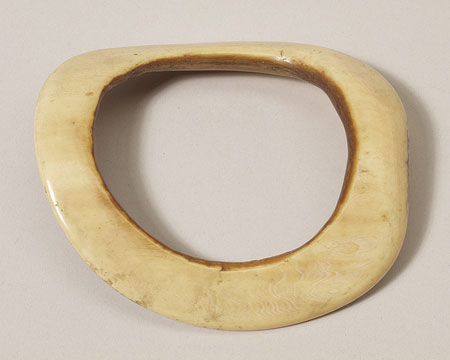Accession Number:
1917.25.82
Country:
Sudan
Region:
[Southern Sudan?] [White Nile]
Cultural Group:
Dinka
Date Made:
By 1917
Materials:
Elephant Tooth Ivory Animal
Process:
Carved , Polished
Dimensions:
Max L = 111.7 mm Max W = 99 mm Max Th = 8.5 mm [RTS 25/3/2004].
Weight:
65.9 g
Other Owners:
Robert Grenville Gayer-Anderson, probably collected in the period immediately before World War I (1909-1914) [RTS 1/6/2004].
Field Collector:
Robert Grenville Gayer-Anderson
PRM Source:
Robert Grenville Gayer-Anderson
Acquired:
Donated 1917
Collected Date:
By 1917
Description:
Annular ivory arm ornament, carved in one piece, consisting of a narrow ring, roughly oval in shape but flattened on one side, with a sub rectangular section.
The upper surface is convex, with the body sloping downwards to the outer edge.
All surfaces are polished.
The object is complete, but the ivory is beginning to laminate on the underside near one edge and there is some surface damage here.
It is currently an opaque creamy yellow colour (Pantone 7403C), and measures 111.7 mm by 99 mm across the outside edges, and 74.6 by 66.4 mm across the inside edges, with a thickness ranging from 3.3 to 8.5 mm and a weight of 65.9 grams.
Collected by Robert Grenville Gayer-Anderson, probably sometime between 1909 and 1914, in the area of the White Nile.
Domville Fife suggested that ivory bangles were worn by Dinka men who had speared an elephant (C.W. Domville Fife, 1927, Savage Life in the Black Sudan, p. 129); he does not give any specifics as to the actual form of the armlet, but gives it the name afjok. This is probably the term that appears in Nebel as apiok, meaning an ivory armlet. An alternative term is given as atum (ivory, round) (Nebel 1979, Dinka-English Dictionary, p. 106).
For similar arm ornaments, see 1952.5.77 (Dinka) and 1917.25.78.
Rachael Sparks 30/9/2005.
Collected by Robert Grenville Gayer-Anderson, probably sometime between 1909 and 1914, in the area of the White Nile.
Domville Fife suggested that ivory bangles were worn by Dinka men who had speared an elephant (C.W. Domville Fife, 1927, Savage Life in the Black Sudan, p. 129); he does not give any specifics as to the actual form of the armlet, but gives it the name afjok. This is probably the term that appears in Nebel as apiok, meaning an ivory armlet. An alternative term is given as atum (ivory, round) (Nebel 1979, Dinka-English Dictionary, p. 106).
For similar arm ornaments, see 1952.5.77 (Dinka) and 1917.25.78.
Rachael Sparks 30/9/2005.
Primary Documentation:
Accession Book Entry
[VI, p.
54] - 1917 [pencil insert] 25 [end insert]
MAJOR R.G.
GAYER-ANDERSON
, R.A.M.C.
The Lodge, Old Marston, Oxon [pencil insert, p.
56] 77-82 [end insert] - [1 of] 6 Dinka armlets of elephant ivory, White Nile.
Additional Accession Book Entry [page opposite 54] - A gift to the Pitt Rivers Museum in memory of Major R.G. Gayer-Anderson, Pasha, his twin brother Colonel J.G. Gayer-Anderson, C.M.G., D.S.O.
Card Catalogue Entry - The catalogue card repeats the accession book entry, as a group for the six armlets, but is annotated with three negative numbers: A20.F10.15, A20.F10.21 and A20.F10.23. It is not clear which number belongs with which object [RTS 9/3/2004].
Related Documents File - Two letters dated 30/03/1917 and 13/04/1917 from the donor to Henry Balfour regarding the donation of the collection to the museum [EB 12/11/2001]. These indicate that the material was collected by Robert Gayer-Anderson himself, chiefly from the areas of Nuba, Kordofan and Bahr el Ghazal during 5 years he spent in the Sudan, and that they were given to the museum as an unconditional gift [RTS 5/12/2003]. The note in the accession book calling this gift 'in memory of' R.G. Gayer-Anderson is therefore somewhat enigmatic, as both Robert and his twin brother (Thomas G., not J.G.) were alive at the time of the transfer [RTS 5/12/2003].
Pitt Rivers Museum label - AFRICA, SUDAN WHITE NILE DINKA Ivory armlet Donated Major R.G. Gayer-Anderson 1917 1917.25.82 [LM 'DCF 2004-2006 What's Upstairs?' 12/10/2005]
Written on object - DINKA armlet. WHITE NILE. Major R.G. Gayer Anderson 1917 [RTS 25/3/2004].
Additional Accession Book Entry [page opposite 54] - A gift to the Pitt Rivers Museum in memory of Major R.G. Gayer-Anderson, Pasha, his twin brother Colonel J.G. Gayer-Anderson, C.M.G., D.S.O.
Card Catalogue Entry - The catalogue card repeats the accession book entry, as a group for the six armlets, but is annotated with three negative numbers: A20.F10.15, A20.F10.21 and A20.F10.23. It is not clear which number belongs with which object [RTS 9/3/2004].
Related Documents File - Two letters dated 30/03/1917 and 13/04/1917 from the donor to Henry Balfour regarding the donation of the collection to the museum [EB 12/11/2001]. These indicate that the material was collected by Robert Gayer-Anderson himself, chiefly from the areas of Nuba, Kordofan and Bahr el Ghazal during 5 years he spent in the Sudan, and that they were given to the museum as an unconditional gift [RTS 5/12/2003]. The note in the accession book calling this gift 'in memory of' R.G. Gayer-Anderson is therefore somewhat enigmatic, as both Robert and his twin brother (Thomas G., not J.G.) were alive at the time of the transfer [RTS 5/12/2003].
Pitt Rivers Museum label - AFRICA, SUDAN WHITE NILE DINKA Ivory armlet Donated Major R.G. Gayer-Anderson 1917 1917.25.82 [LM 'DCF 2004-2006 What's Upstairs?' 12/10/2005]
Written on object - DINKA armlet. WHITE NILE. Major R.G. Gayer Anderson 1917 [RTS 25/3/2004].





